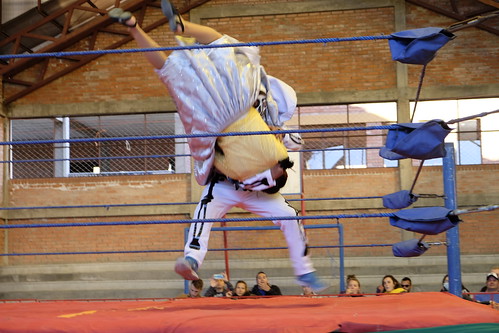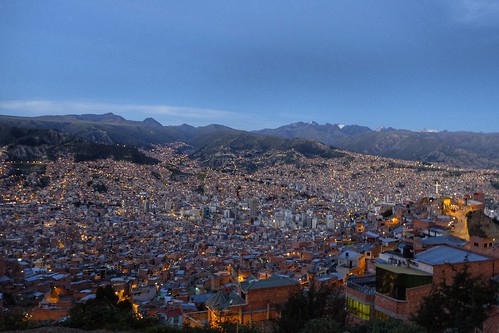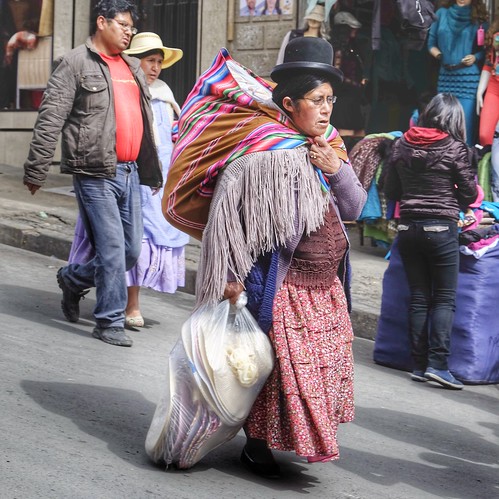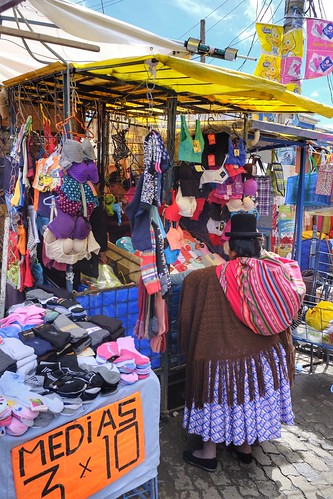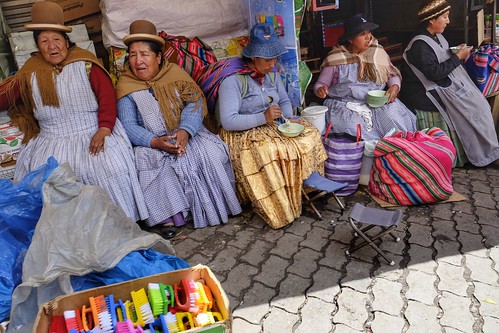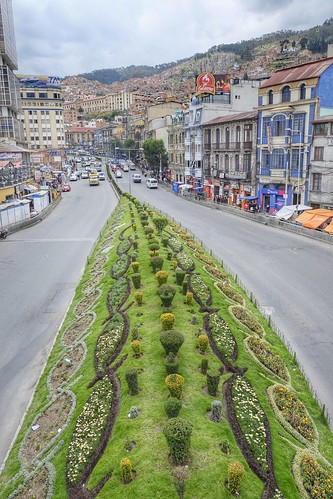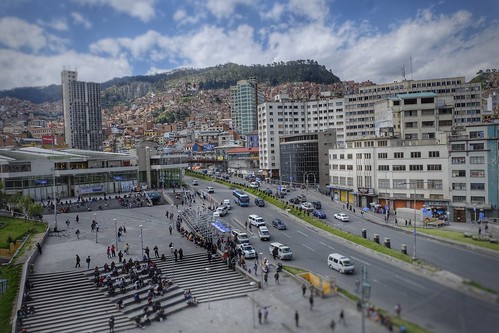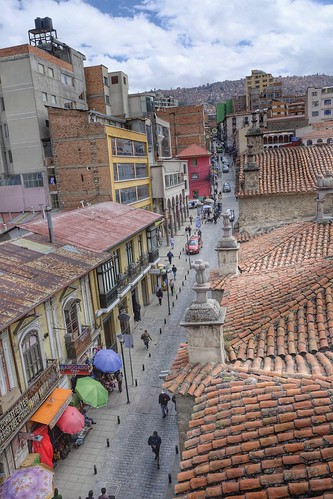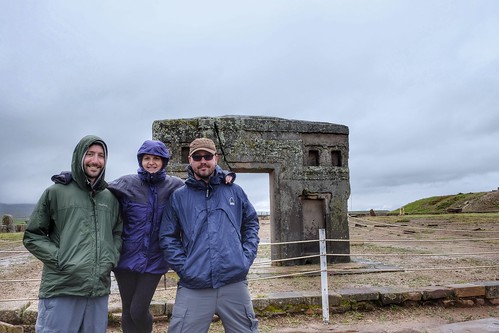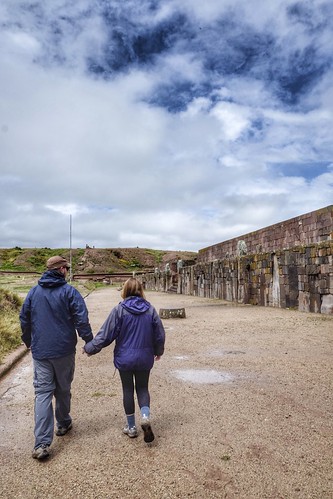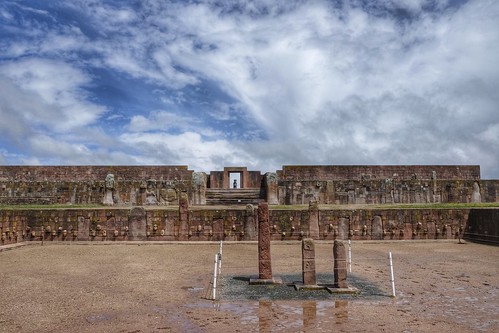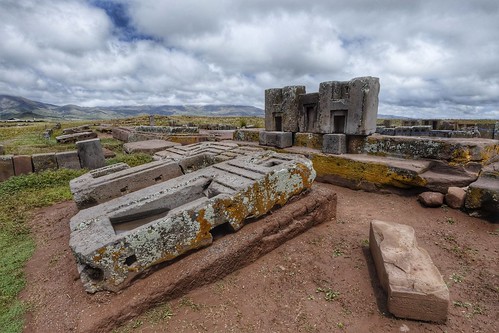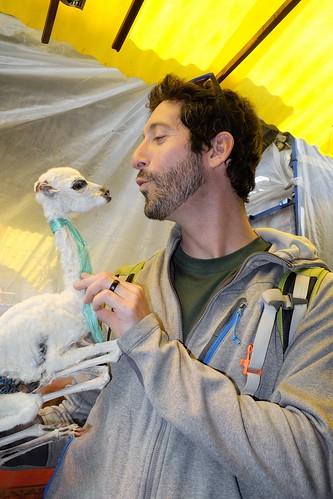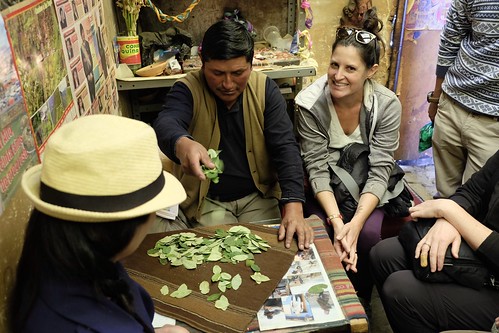The city of La Paz, Bolivia sits at a sky high 11,483 ft. above sea level, and within minutes of landing at the airport there, we started to feel the affects of the altitude. We set aside 5 days to spend there so we could take our time adapting to the “high” life, but also to run some important errands like finding a new lens cap since I dropped ours in a river and locating fresh coca leaves and learning how to chew them before the main event, the arrival of my sister, Stefanie, and her boyfriend (and super close friend of mine) Doug. They planned about 2 and a half weeks of Bolivia travel with us, starting with a few days in La Paz.
La Paz is a site to behold; it’s a city in a giant valley with neighborhoods creeping up from the basin onto the steep sides. Atop the valley, on a high-altitude plain, there is a second large city, just as populous as La Paz, called El Alto City. It is one crowded valley, and in the background of it all lies the Andes mountain range, with its snow-capped peaks visible on clear days.
Before arriving we had heard mixed reviews of all sorts about La Paz, and I must admit, my own opinion after a full 5 days is a mixed bag still. There are so many layers to this city. There are orange brick houses layered up the hill on seemingly every piece of property available, giving the valley an orange glow. There are layers of narrow streets meeting up with wide boulevards and then again meeting narrow streets. On most streets there are layers of market stalls in front of the storefronts, and more market stalls lined up in front of those, and then people sitting on the pavement with their goods in front of those. There are layers to the traditional clothing the women wear, like their multi-layered, colorful skirts, shawls, and quipes (bright fabric bundles wrapped around goods or babies and carried on their backs).
At first we were taken by the colorful, walkable layers and interesting street scenes that were so different from anything we had yet seen in South America. The traditional indigenous factor topped what we had experienced in Ecuador. I could not stop clicking away on the camera, trying to capture the bustling street scenes and markets. But as we got to know the city more, the colorful layers gave way to a bit of a dark side. Plus, I think we stayed long enough to see more than the average tourist. In reality, La Paz is a very poor city with a garbage problem, lots of traffic followed by some serious smog, third world sanitation problems like terrible plumbing and people publicly urinating into storm drains (I saw that happen a few times), and the most disappointing of all, a general unfriendliness to foreigners.
Regardless, we really did enjoy our time in La Paz and as I wrote down some bullet points for myself for writing this post I realized we have some really fun stories to share. Luckily our hotel was one of the nicest places we had stayed in some time. In the jungle we hadn’t slept inside our sheets, not a single night, because of the heat and the bugs were just everywhere. Our hotel became our oasis and the best place to find a clean bathroom when we each had our moments with Bolivia belly. When Stef and Doug arrived we had already gotten the lay of the land in the neighborhood around our hotel and were very excited to show them around. After months of traveling just the two of us we were ready to have some good friends around! Stef and Doug didn’t need much time to adapt to the altitude; they were total troopers, and from the moment they arrived we started packing in the sites.
Highlights from La Paz (pre Stef and Doug’s arrival)…
- As Danny was kind enough to point out and emphasize in the last post, I was responsible for losing our lens cap in the river a few days before arriving to La Paz. So errand número uno was to go on a scavenger hunt mission for a new one. La Paz is like one gigantic market, with streets dedicated to specific items, like a street for light bulbs, a street for kids stuff, a street for shoes, a street for rope, etc. There was a street for electronic stuff too and Danny and I huffed and puffed all the way up a hill (not easy in altitude) to the electronic street 2 days in a row to look for a suitable lens cap replacement. The first day we thought we had it nailed, as we saw exactly what we needed in a glass case. But the case was locked and the owner of the shop wasn’t around. His friend who was watching the shop called the owner and then told us that the owner would be back in a few minutes. We waited around for about 15 minutes before we decided to walk off, and we told the friend we would return soon to purchase the lens cap once the owner was back. Sure enough, we returned another 15 minutes later and the shop was completely locked up and empty. I guess they didn’t want our business! The next day we hiked back up to the electronics street to try again and even though that stupid shop was closed again, we were lucky enough to find a lens cap somewhere else on the block. We did spend a fair amount of time looking for the darn thing, but honestly, I can’t believe we were able to find one at all!
- We made a last minute decision to see something called “Cholita Wrestling”, and it was definitely a unique experience. Cholitas are the traditionally dressed women, so think traditionally dressed indigenous woman meets WWE wrestling and that’s exactly what we saw. It was kind of awkward to be honest, since there wasn’t a huge crowd, but Danny, and all the other guys in the room, were seemingly really into it. I do get a kick out of imagining these women huddled around YouTube videos of WWE, learning new moves. There were definitely some impressive acrobatic body slams and throw downs and that’s where my WWE vocabulary ends.
- We met Erik Catari for dinner, the godson of a family friend from the states. Erik is Bolivian, from a small village near Lake Titicaca, where generations of his family are well known for their superior reed boat making skills. They actually have a museum about reed boats that we would later visit. Erik currently lives in El Alto City with his wife and son. We had a nice time chatting with him during dinner, mostly in Spanish, although he speaks decent English. It was interesting for us to hear from someone around our age who lives in Bolivia and to understand what’s happening there, and his opinions on Bolivian politics and such.
Highlights once Stef and Doug Arrived..
- On our first full day with Doug and Stef we did a day trip up to the high altitude plain outside of the city to visit the ruins of Tiwanaku and Puma Punku. Tiwanaku was the capital city of a huge empire that reached as far as present day Chile and Peru, and ruled from around 300 AD to 100 AD. I first heard about these ruins from the TV show Ancient Aliens, on TLC. I had a stint of complete obsession with that show and had since wanted to visit Tiwanaku and Puma Punku to check it all out for myself. Tiwanaku has a large monolithic gate called the Gate of the Sun that may (or may not) have an astronomical calendar carved into it. Puma Punku is a temple complex just across the street from Tiwankau, and the show claims that the giant H shaped blocks there are too perfectly cut and precise to have been made by a primitive, machine-less culture. There are also a few other examples there of beveled blocks and blocks with perfectly round holes that are so huge that it’s difficult to understand how they were moved and cut. I made my case to the crew, our guide included, and was pretty quickly rebuffed by what seems to be real facts about the Tiwanaku culture. As it turns out, archaeologists and historians do know a fair amount about their culture eventhough they lacked a written language. My archaeology nerdiness was fed for a bit, and even though we were caught in some rain during our time there, we managed to see all the ruins had to offer, including an onsite museum.
- During our time in Bolivia we each, to varying degrees, had our moments of feeling ill from altitude and likely some sort of contaminated food. My moment, which was the worst of the group during our time in La Paz, arrived later in the day after our visit to the ruins, and I spent the rest of the day and night feverishly shaking in bed at the hotel. Luckily by morning I was feeling a bit better but it definitely took a few days to get it out of my system!
- We did a full day city walking tour with a small group and an amazing guide. We had a pretty funny group, especially this one girl from San Francisco (not Stef) who was so annoying that we continue to get some good laughs from her classic lines, including her insisting that her friend hold her hand whenever we were near steep ledges because she has a primitive bird-gene desire to jump and try to fly. The guide took us to a total locals market up in El Alto City where we saw an area of witch doctor booths and Danny and Doug got to pose with a mummified llama fetus. We also got our fortunes read by an old guy at the market who reads coca leaves. According to my fortune, my mate will be unfaithful to me if I don’t pay enough attention to him. Not sure if he knew that my mate was sitting in the room!
- La Paz has about 4 new gondola transportation systems that look like traditional ski lift gondolas but act as a form of public transportation. Definitely a unique idea, but really genius for a city with such steep hills and a traffic problem. We took the yellow line gondola on our walking tour and were treated to an incredible overhead view of the city.
- To end our city walking tour we actually bused out to a geological dirt formation just outside the city called the Moon Valley. We were there just before sunset and saw a rainbow as well, which all made for a great photo op.
- Stef and Doug did some venturing on their own one evening, hitting about 5 museums in the process, and finding a big street festival in the San Francisco Plaza right in front of our hotel. But the skies opened up and they got poured on!
To see the full album of La Paz photos click here.

